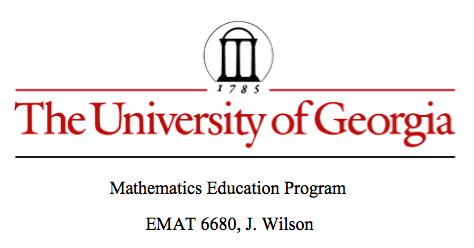

Assignment #4
Perpendicular Bisectors
by
Megan Dickerson
I will prove that the three perpendicular bisectors of a triangle are concurrent.
1.) Create triangle ABC

2.)Find the midpoints of sides AB, BC, and AC and label them D,E,and F.

3.)Construct the perpendicular bisector lines to sides AB and BC.

4.) Since sides AB and BC are not parallel, then neither are their perpendicular bisectors. So, these perpendicular bisectors will meet at a point. call this point G.

5.) Now, my goal is to show that the perpendicular bisector of AC goes through the same point G. Go ahead and construct the perpendicular bisector of AC, and then I will prove that it goes through this point.

6.) Now join line segments AG, BG, and CG.

7.) Prove triangle ADG is congruent to triangle BDG by SAS.
Side AD is congruent to side DB by definition of bisector.
Side DG is common to both triangles.
And
since DG is a perpendicular, angle ADG and angle GDB are both right angles and congruent.
Because these triangles are congruent, we can say that side AG is congruent to side BG
![]()
8.) Now, prove triangle GBE is congruent to triangle GCE by SAS.
Side BE is congruent to side EC by definition of bisector.
Side GE is common.
Since GE is a perpendicular then angle GEB and angle GEC are both right angles and therefore congruent.
Since these triangles are congruent then side BG is congruent to side CG.
![]()
9.) Now look at triangles AFG and CFG. They are congruent by SSS.
Side AF is congruent to side FC by definition of bisector.
Side FG is common to both.
And since side AG is congruent to side BG and side BG is congruent to side GC, then side AG is congruent to side GC by transitivity.
So since triangles are congruent then angle AFG is congruent to angle CFG.
And, since angle AFG + angle CFG = a straight line, then they must each be equal to a right angle.
![]()
10.) So, since line FG forms right angles to line AC and bisects side AC it is a perpendicular bisector and goes through point G. Therefore, all three perpendicular bisectors are concurrent.

Further Explorations
Then, in a classroom setting it would be good to show how when the sides are moved this point of concurrency, known as the circumcenter, changes location.
Here are 2 examples with the sides moved and all points labeled the same.


It would also be good to show how the circumcenter is also the center of a circle that circumscribes the triangle (all three points of the triangle are on the circle. This would be a great way to explain this vocabulary, too.

I like using green for the connections of G to the vertices because it might help them make the connection that since we proved all three of these green dotted lines to be congruent they are all radii of the circle.